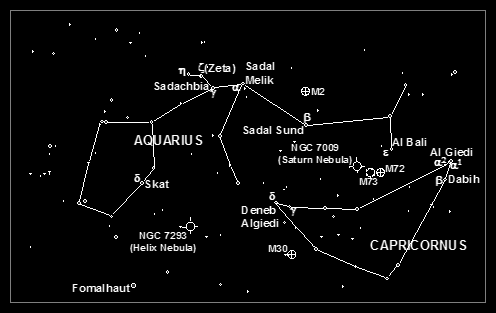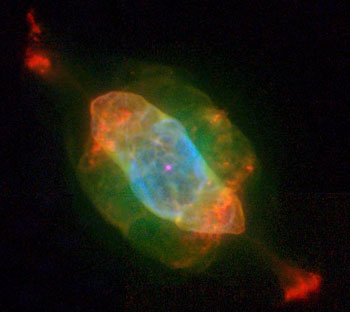Aquarius and Capricornus
Aquarius and Capricornus possess between them no star brighter than the third magnitude but due to being situated on the Zodiac, the band of the heavens along which the planets travel, they both number amongst the original 48 constellations of Ptolemy’s “Almagest”. Between them they also possess sufficient interesting double stars and deep sky objects to compensate for their somewhat drab naked eye appearances.
Al Giedi (Alpha Capricorni) is a very wide binocular double and in fact the separation of 6 arcminutes makes the pair a test for good naked eye vision. The components have magnitudes of 3.6 and 4.2 and telescopes show each star to be double again. Nearby Dabih (Beta Capricorni) is also a wide binocular double, consisting of a third magnitude orange primary and sixth magnitude white secondary, with a separation of 3 arcminutes. Unlike Al Giedi, Dabih is thought to be a true physical system albeit with an orbital period of the order of a million years. Spectroscopic and lunar occultation studies have shown that the fainter star is double again and the brighter star to be at least a triple system. Another very attractive double is the white pair Zeta Aquarii, in the so-called “Water Jar” asterism. This time the split is tight at 1.7 arcseconds but the near equality in magnitude (4.4 and 4.6) makes separation relatively easy.

NGC7009 (HST Image)
Aquarius and Capricornus possesses between them three globular clusters from the Messier catalogue. The most impressive of these is sixth magnitude M2, thought to be 50,000 light years from us. The other two are 9th magnitude M72, also in Aquarius and 8th magnitude M30 in Capricornus. Close to M72 is one of the more curious of Messier’s inclusions. This is M73, a small asterism consisting of only four stars.
Last, but not least, Aquarius has two excellent planetary nebulae. These are NGC 7009 and NGC 7293. The former is often known as the “Saturn” nebula because the rays or “ansae” emerging from it give it at least a superficial resemblance in appearance to the ringed planet. NGC 7293 is usually known as the “Helix” nebula, again from its characteristic appearance. It is the largest and possibly closest of the planetaries, although its low surface brightness means that a clear, dark sky is required to observe it visually.
POWERPOINT SLIDE SHOW (264KB)